#mda2000921
Text
Slow Fashion & Social Media Influencers
Week 9
The world of digital citizenship and the ‘slow fashion’ movement are not considered new, but they have been gaining significant attention in recent years (Lai et al. 2017). The slow fashion movement has increased the awareness of sustainability and responsibility when it comes to fashion consumption. This rise has particularly been seen and felt through its social media traction.
The slow fashion movement first gained attention in the 1960s being linked to counter culture, then again in the 1980s in the form of anti-fur campaigns (Lai et al. 2017). It made another appearance in the 1990s and early 2000s through protests against unjust working conditions (Lai et al. 2017). Sustainable fashion includes services and goods that are relevant for basic needs, that decrease the use of toxic materials and waste emissions and pollutants over the life of the good or service (Lai et al. 2017). Sustainable fashion’s main aim is to not threaten the needs of future generations (Lai et al. 2017).
In today’s social media rich times, there are many influencers and corporations dedicated towards sustainable fashion. They make sustainable fashion their brand. This is a welcome change from the fast fashion hauls and overall saturation of it that we saw across the 2010s. We are seeing a lot more influencers favouring the slow fashion movement particularly through thrifting. Thrifting is going through a trending period now, where more people are open to upcycling other people’s clothes and through donating their own clothes. Another way to engage in the slow fashion movement is through fashion marketplace apps such as Depop or Carousell. There is the notion now in the slow fashion community that the gentrification of thrift stores or op shops is making access to affordable clothing more difficult for lower-income communities (Delgado 2020). As more middle-income and higher-income individuals shop there, causing prices to increase (Delgado 2020). It is therefore important to be aware of and assess your own needs when you’re looking to buy at thrift stores and not bulk buy when it is unnecessary. Thrifting is not bad by any means and should be encouraged, however but being exploitive with it through marked up resales or bulk buying is (Delgado 2020).
Good On You is a website and app that allows you to search for fashion brand ratings. These ratings are calculated in terms of brands’ ethical and sustainable practices, with their three main categories being planet, people and animals (Good On You 2021). Good On You is considered the benchmark for sustainable fashion (Good On You 2021).
Here is the link if anyone wants to check it out: https://goodonyou.eco/
Consider the things you buy.
~

References:
Delgado, V 2020, Thrift reselling is unethical, North Texas Daily, viewed 9 May 2021, <https://www.ntdaily.com/thrift-reselling-is-unethical/>.
Good On You, 2021, Wear the change you want to see, Good On You, viewed 9 May 2021, <https://goodonyou.eco/about/>.
Lai, Z, Henninger, C, Alevizou, P & Cham, J 2017, ‘An Exploration of Consumers’ Perceptions Towards Sustainable Fashion – A Qualitative Study in the UK’, Springer International Publishing Sustainability in Fashion, pp. 81-101.
8 notes
·
View notes
Text
Week 10 - Digital Communities and Online Harassment
As the Internet and Social Media grew over the years, the World Wide Web turned into a Wild Wild West, as digital communities saw conflict and harassment rise. The Office of eSafety Commissioner, NSW Department of Justice said that “a good digital citizenship is a person with skills and knowledge to effectively use digital technologies in a positive way to participate in society, communicate with others, and create and consume digital content.” Sadly more often than not we see examples of a bad digital citizen instead of a good one.

In an article by The Conversation they said that online harassment is a form of violence, and that it stems from having or wanting power. “All violence is about a person or person(s) having power and control over another. The uses and misuses of technology are part of this daily power struggle, especially for girls and women. The solutions aren’t easy.” (Ostini & Hopkins, 2015).
It makes sense that women and people of colour are the most targeted online, as the harassment comes down to the power to attack wants to have or keep.
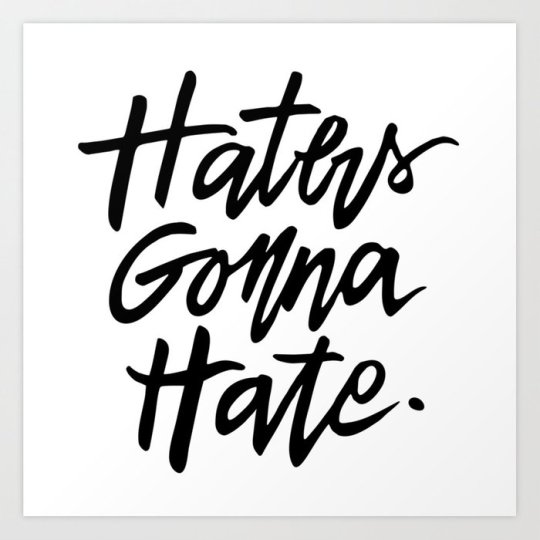
The Guardian looked at its own comments threads for instances of hate. After looking at 70 million comments left, they found the 10 regular writers who receives the most hate and abuse were eight women (four white and four non-white). The remaining two were black men. The ten writers who got the least abuse were all men (Gardiner et al., 2016)
The way forward will be education, so many people joined social media without understanding its impacts. Some people joined social media in their teens, others discovered it in their 50’s. The one thing in common would be all age groups contribute to online harassment.
Gardiner, B, Mansfield, M, Anderson, I, Holder, J, Louter, D and Ulmanu, M 2016, The dark side of Guardian comments, Guardian.com, viewed 24 May 2021, https://www.theguardian.com/technology/2016/apr/12/the-dark-side-of-guardian-comments
Ostini, J and Hopkins, S, 2015, Online harassment is a form of violence, theconversation.com, viewed 24 May 2021, https://theconversation.com/online-harassment-is-a-form-of-violence-38846
7 notes
·
View notes
Text
Week 10: Digital Citizenship and Conflict: Social Media Governance
One of the cons of being able to share your opinions and life online is the conflict that comes with it. The power that social media has to create digital communities opens up areas for hate and negativity which is becoming increasingly more worrying with the number of young people on these platforms.
Gaslighting is a term that was defined in one of this week's readings as "psychological manipulation of a person in order to erode their sense of self and sanity" (Gleeson, 2018). The term came from the 1944 film, Gaslight, where a woman was deliberately and gradually manipulated by her husband into believing she is insane. You may have been gaslit by someone you know or witnessed it on social media. You may have even gaslight someone before and not have known. Common tactics can include manipulating your words, denying your feelings, insist things happened a certain way or making you feel inferior.

Governments and organisations have put in place social media codes of practice to protect users when online and may find themselves in a situation of conflict. This doesn't have to just be gaslighting, it can be in different forms of bullying, trolling or hating from anonymous accounts and hidden identities. The anonymity that social media creates is a big factor in why conflict arises when someone is hidden behind their keyboard.
Conflict ties together topics that we have discussed over the semester such as digital citizenship, activism, regulation, platforms, community and inclusion. The increased availability of internet services has grown the amount of conflict and activism that occurs online. Whether there is conflict in the comments of a Facebook post about depicting breastfeeding or a female has posted a bikini photo on Instagram and is now receiving hateful speech and threats in her direct messages.
Regulations for your social media use may be controlled by your school, your workplace or the specific app you may be using. These interests can sometimes have conflicting interests depending on the industry bodies who are developing these standards, however, they all play a part in protecting us online.
Although there is some form of social media governance already in place, Marwick and Caplan gave an example of a Youtube channel that posts video online that are blatantly portraying harassment of women. These videos have gained a lot of attention and views and yet nothing has been done to take these sorts of videos down. This example is one of many that prove we still have a long way to go in making the online public sphere a safer place.
References
Gleeson, J 2018, Explainer: what does ‘gaslighting’ mean?, The Conversation, viewed 14 May 2021, <https://theconversation.com/explainer-what-does-gaslighting-mean-107888 >.
Marwick, A & Caplan, R 2018, ‘Drinking male tears: language, the manosphere, and networked harassment’, Feminist Media Studies, vol. 18, no. 4, pp. 543-559.
#mda2000921#digital communities#gaslighting#feminisim#conflict#online harrassment#social media guidelines#governance
7 notes
·
View notes
Text
Week 10: Digital Citizenship, Conflict and Social Media Governance – Gaslighting & Gamergate

It comes to no surprise that social media is a multifaceted tool. As discussed in previous weeks, social media has the power to create and maintain digital communities, and you reading this right now likely means that you are part of an online community yourself. However, where there are positives, there are often negatives; this is no different for social media. The online world often fosters conflict, with ‘gaslighting’ becoming a common practise. But what exactly is gaslighting?
Gaslighting got its name from the 1944 film Gaslight, where the wife is deliberately and gradually manipulated by her husband into believing that she is insane. He does this by sneaking off and causing the lights to flicker and dim, all whilst denying this knowledge and leading his wife to question her sanity (Gleeson 2018). Although, it is not always deliberate, gaslighting is often used as a method of power and control and is becoming a commonly used term in society, both online and offline. Although, the word carries negative connotations, “it signifies a deeper understanding of what abuse looks like and the many forms it can take” (Gleeson 2018).
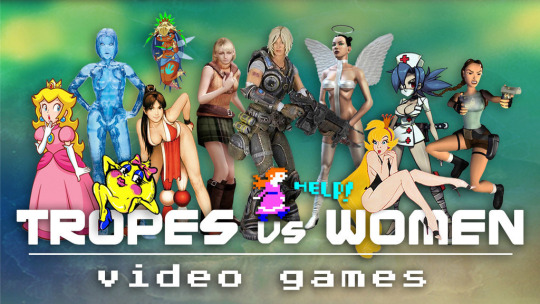


Following the theme of social media conflict and governance is the protracted online controversy known as Gamergate. Referred to as an “internet culture war” (Dewey 2014), Gamergate sparked a heated debate. On one side were independent game creators and critics, many being women, who advocate for greater inclusion in gaming; with the other side consisting of misogynist, anti-feminist trolls who refuse to have their games changed (Dewey 2014). Many of the men’s rights activists and anti-feminists used “network harassment, such as doxing (publishing personal information online), revenge porn (spreading intimate photos beyond their origins), social shaming and intimidation” (Marwick and Caplan, 2018), with gamers including Zoe Quinn, Anita Sarkeesian and many others falling victim to this.
Today, the “justice system continues to be slow to understand the link between online harassment and real-life violence. There are more laws about online harassment now and more prosecutions, but police are often untrained and undereducated…[leaving people] unsatisfied with the [legal] response” (Romano 2021).
Although, there are laws in place such as the Criminal Code Act 1995 and the Enhancing Online Safety Act 2015, more needs to be done about police officers and society becoming more familiar with the severity of violence and harassment online. If we don’t start becoming better digital citizens now, what will our future look like?
References:
Dewey, C 2014, “The only guide to Gamergate you will ever need to read,” Washington Post, The Washington Post, viewed 12 May, 2021, <https://www.washingtonpost.com/news/the-intersect/wp/2014/10/14/the-only-guide-to-gamergate-you-will-ever-need-to-read/>.
Gleeson, J 2018, “Explainer: what does ‘gaslighting’ mean?,” The Conversation, viewed 12 May, 2021, <https://theconversation.com/explainer-what-does-gaslighting-mean-107888>.
Marwick, A.E, & Caplan, R 2018, Drinking male tears: language, the manosphere, and networked harassment, Feminist Media Studies, 18:4, 543-559.
Romano, A 2021, “What was Gamergate? The lessons we still haven’t learned,” Vox, viewed 12 May, 2021, <https://www.vox.com/culture/2020/1/20/20808875/gamergate-lessons-cultural-impact-changes-harassment-laws>.
#mda2000921#digitalcommunities#social media#gaslighting#violence#online harassment#cyberbullying#gamergate#online#digital citizenship
8 notes
·
View notes
Text
Social Media: encouraging unsustainable and unethical fashion? (Week 9)
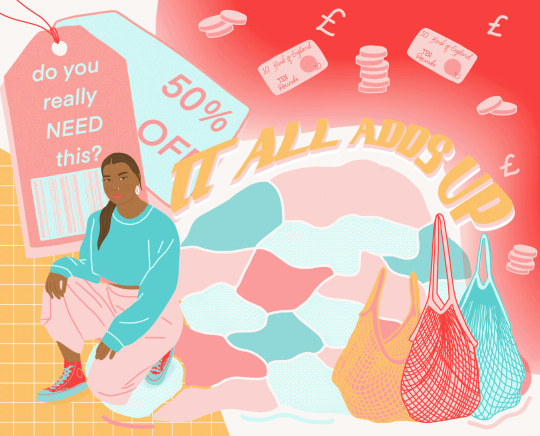
Social Media is known to establish trends; dances, food, photography. In particular, social media is a catalyst for new fashion trends. The ability for an influencer to post a photo in a particular outfit, and simultaneously compel their followers to buy similar outfits or clothing from that brand is a testament to the power of social media within modern society. However, with this power, comes great responsibility, and unfortunately, this responsibility has been lacking within recent years. Whilst influencers are great at setting trends and influencing the decisions, opinions and purchasing habits of consumers, regarding fashion and clothing, these influencers are less effective at ensuring the promotion of sustainable and ethical fashion.
Sustainable fashion refers to those ‘goods and services that respond to basic needs and bring a better quality of life, while minimizing the use of natural resources, toxic materials and emissions of waste and pollutants over the life-cycle, so as not to jeopardize the needs of future generations’ (Lai et al 2017, pg. 83). Generally, sustainable fashion rejects the unethical nature of fast fashion, denouncing the ‘throw away attitude’ (Lai et al 2017, pg. 82) of ‘mass-produced’ (Lai et al 2017, pg. 82 ) and ‘cheap’ (Lai et al 2017, pg. 82) clothing. Sustainable fashion promotes the use of ethically sourced materials and production of clothing in an effort to limit the amount of textile waste that the fashion industry produces.
There have been huge efforts of recent years within the fashion industry to reform unethical and unsustainable productions and manufacturing. Brands such as H&M, Nike, Adidas and Levis are leading the charge in sourcing sustainable materials for their products and innovating new and ethical forms of production. Despite this, the benefits of sustainable fashion are still significantly threatened by social media and the relationship between influencers and fast-fashion.
Lai identified that whilst consumers generally understand and agree that the fashion industry needs to ‘change’ (Lai et al 2017, pg. 88) and ‘become more environmentally and socially responsible’ (Lai et al 2017, pg. 88), they have little ‘awareness’ (Lai et al 2017, pg. 88) about the sustainable fashion movement. Moreover, whilst consumers generally associate sustainable fashion with ‘natural’ (Lai et al 2017, pg. 89), ‘simple’ (Lai et al 2017, pg. 89) and ‘locally made’ (Lai et al 2017, pg. 89) clothing, the lack of ‘awareness’ (Lai et al 2017, pg. 88) about what the movement is trying to achieve leads these consumers to develop negative ‘perceptions and attitudes’ (Lai et al 2017, pg. 88) towards it.
The lack of awareness surrounding the sustainable fashion movement can be correlated with the impact of influencers and fast fashion on social media. Many consumers buy clothing based on what their favourite influencers are wearing. Unfortunately, however, many influencers do not actively seek to post about sustainable fashion. As influencers can directly influence the purchasing habits of their followers, posting paid sponsorships with fast fashion companies also directly compels these followers to become consumers of fast fashion.
Moreover, through influencers not actively getting involved in the sustainable fashion movement, negative ‘perceptions and attitudes’ (Lai et al 2017, pg. 88) towards the movement are encouraged. These perceptions include that sustainable fashion is ‘less fashionable’ (Lai et al 2017, pg. 92) than its ‘fast fashion counterparts’ (Lai et al 2017, pg. 92), and that sustainable fashion is ‘too expensive’ (Lai et al 2017, pg. 91). Through the proliferation of these perceptions, the sustainable fashion movement’s main objectives are forgotten, and it becomes more difficult to hold the fashion industry accountable for its large contributions to the environmental crisis.
Despite this, there is still hope. Influencers can take responsibility on their platforms to inform and compel their audiences to choose sustainable fashion over fast fashion. Through doing so, the demand for fast fashion will slowly decrease, and so will the need for the unethical production of ‘mass-produced’ (Lai et al 2017, pg. 82) and ‘cheap’ (Lai et al 2017, pg. 82) clothing, that only purports a ‘throw away’ (Lai et al 2017, pg. 82) culture.
References:
Zhen Lai, Claudia E. Henninger and Panayiota J. Alevizou ‘An Exploration of Consumers’ Perceptions Towards Sustainable Fashion – A Qualitative Study in the UK’, in Sustainability in Fashion A Cradle to Upcycle Approach, edited by Henninger, C.E., Alevizou, P., Goworek, H., Ryding, D. (Palgrave: 2017).
References:
#digitaldiscussions#digital#fast fashion#sustainable fashion#ethical fashion#digital citizenship#digitial citizen#public sphere#climate change#influencers#mda20009#mda2000921#digital communities
7 notes
·
View notes
Text
Week 10: Digital Citizenship and Conflict: Social Media Governance
For as long as there has been social media, there has been social media harassment and misconduct. It is important to discuss social media harassment as often social media is discussed as something wholly positive.
Social media harassment is an umbrella term which can refer to being called offensive names, being embarrassed online, being physically threatened online, being sexually harassed online, being harassed over a long time, being hurt online by a romantic partner, being impersonated, spreading damaging rumours online, encouraging others to harass you online, and attempting to hurt the victim in person after online harassment. (Lenhart, et al in Marwick & Caplan R 2018, pg. 544-545).
A prime example of subtle online harassment could be “gaslighting”. A term which has risen in prominence in recent years. The central tenet of gaslighting is the psychological manipulation of a person in order to erode their sense of self and sanity. (Gleeson 2018). Gaslighting’s re-emergence in our day-to-day vernacular is in part due to a wider societal focus on violence against women. (Gleeson 2018).
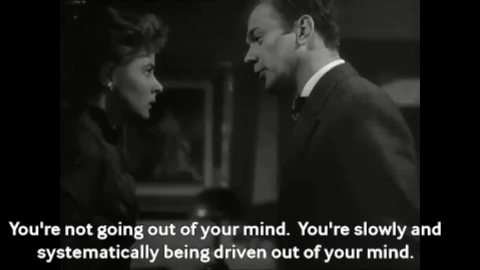
This week's lecture focused on the harassment women face online, and how many forms of social media harassment are heavily used against women. For example, planned and networked harassment such as doxing, revenge porn, social shaming and intimidation were used by mens rights activists and anti feminist gamers during a protected online controversy known as Gamergate (Marwick A & Caplan R 2018, pg. 544)
As a result of social media harassment and misconduct, there is social media governance. Most social media platforms have systems in place to protect and censor users from harassment, in addition to keeping platforms safe and preventing harmful people from having a platform for their hate speech. These methods of governance are quite complex as they have to cover multiple and sometimes conflicting interests. These can include the commercial and public sector and different countries approaches with varying internet regulations.
In Australia there is no sadly single piece of legislation against bullying or online harassment. However there are a number of acts which offer some protection to victims. These include The Australian Human Rights Commission Act 1986 and the Enhancing Online Safety Act 2015. (Milne 2021).
It is important to raise awareness on the dark side of social media and to encourage users to be as nice and positive as possible, to create a space that is safe and enjoyable for all users.

3 notes
·
View notes
Text
Week 9: Fast Fashion
In a society where trends are constantly changing, the fashion industry attempts to keep up with the ever-evolving developments. Fast fashion is something I had very little knowledge about a few years ago. Most of the time, I shopped where the clothes were considered ‘trendy’ of the time, but I didn’t realise that these brands were part of the problem. After reading this weeks article about Fast fashion, I decided to look in my closet. I was shocked to realise that I didn’t have one item of clothing from a slow fashion brand. I did have several pieces purchased from second-hand stores, but I decided to make a more conscious effort to shop from sustainable brands.
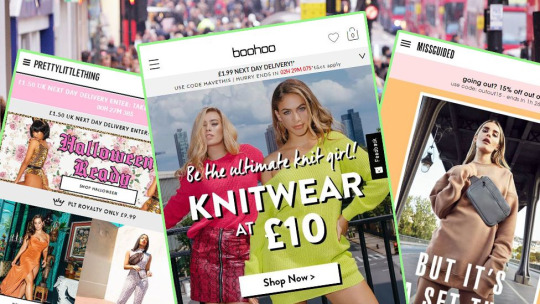
While fast fashion brands are described as “mass-produced, cheap... and often associated with a ‘throw away’ attitude” (Lai, Henniger & Alevizou, 2021, p.82), slow fashion brands must reflect four main elements. To be considered sustainable development, they must include environmental, social, and economic factors. These refer to being free of child labour, utilising materials that are less harmful to the environment, or using recycled items. On paper, this seems great, however, the real issue comes within the actual clothing item itself. Most often, consumers are “seemingly unwilling” (Lai, Henniger & Alevizou, 2021, p.85) to pay for the high price tags which result in sacrificing their choice of clothing items.

Social media also has a significant impact on the Fashion industry alone. Micro-celebrities are seen sharing their most recent purchases in their ‘clothing hauls’, attempting to encourage their followers to support these brands. However, these brands are usually contributing to fast fashion. Social media is helpful, as it creates more “opportunities for dialogue between the public and brands“ (Chen, 2021, p.2) and allows customers to express their interest through comments, likes and shares. Brand communities are formed within “90% of the worlds leading brands” (Chen, 2021,p.1), creating stronger relationships with their followers. Due to these several communities constructed on social media, the constant representation from Fast Fashion brands is incredibly overwhelming. From micro-celebrities to the brands themselves, it is difficult to pull away from the unsustainable brands and move towards sustainable ones.

References:
Chen, Y. (2021). A Social Media Mining and Ensemble Learning Model: Application to Luxury and Fast Fashion Brands. Information, 12(4), 149. doi: 10.3390/info12040149
Lai, Z., Henninger, C., & Alevizou, P. (2021). An Exploration of Consumers’ Perceptions Towards Sustainable Fashion – A Qualitative Study in the UK. In Sustainability in Fashion A Cradle to Upcycle Approach.
3 notes
·
View notes
Text
Week 8 Discussion: Gaming communities, social gaming and live-streaming

For many on the internet, gaming and live-streaming communities provide a place for connection and socialisation. In the past year, new games such as Animal Crossing: New Horizons and Among Us, have amassed large communities of dedicated fans. On platforms such as Twitch and YouTube, some streamers attract audiences numbering in the thousands. Furthermore, on platforms such as Twitter, Tumblr and Reddit, people form fandom communities. These fandoms provide a place to discuss their favourite games and share their own original content, for example, fanart.
During the peak of the COVID-19 pandemic, many sought gaming for lockdown entertainment, as a form of escapism or as a means of socialisation. This lead to a significant increase in the size of gaming communities, as well as the online discussion and sharing of content. In 2020, following the release of the game Animal Crossing: New Horizons, a large and active community was formed. Multiple factors have influenced its popularity during the pandemic. Firstly, the cute and wholesome visuals of the game are attractive to a variety of people and give players a sense of escapism from reality.
It also serves a social function, allowing friends and family to interact and play with each other regardless of physical distance. As MacDonald (2020) observes, the game is "played in social groups" and has a wide variety of features that facilitate interaction with other players. For example, the custom designs feature allows players to create their own clothing and furniture patterns. These can then be shared between players on social media platforms such as Twitter and Reddit. The game also has a wide variety of items, which can be traded between players. These all culminate in a highly social gaming experience. In this way, New Horizons is an example of the positive potential of gaming communities to connect people.
Nevertheless, gaming communities are not without problematic aspects. While games can bring people together, they can also be divisive. For many, especially those who are not straight and/or male, gaming spaces can be exclusionary. The platform Twitch allows streamers to broadcast themselves (often playing games, but not always) to viewers. In many instances, this interaction between a streamer and their viewers in chat can be positive. Taylor (2018, p. 6) comments Twitch is a 'networked broadcast', allowing the audience to become integrated into the show via the synchronous chat window. This promotes a feeling of community between the viewers, who can discuss the stream content in real-time both with each other and with the streamer.
However, the anonymity of Twitch chat and the internet means that viewers are often able to direct vitriol with little to no consequence. As a result, many streamers (especially those who do not fit into the traditional view of a "gamer") are subject to sexist, racist, homophobic and transphobic abuse. This abuse can lead to many streaming communities being unwelcoming to outsiders. Over the years, Twitch has introduced new policies and guidelines in an attempt to curb harassment (Stephen 2020). But ultimately, these measures are only a bandaid solution to a complex, culturally ingrained problem of exclusion.
Overall, gaming and live-streaming communities have the potential to be either welcoming or exclusionary. As New Horizons proves, games can be a place to socialise and share an experience with others. In some instances, Twitch has the same capability, allowing streamers and viewers to form tight-knit communities. However, gaming and streaming communities can also be uninviting, with abuse and harassment shutting many out. The existence of these exclusionary communities suggests a need for change in gaming culture and for proactive solutions which address the issue rather than react to it.
Reference List:
MacDonald, K 2020, ''It's uniting people': why 11 million are playing Animal Crossing: New Horizons', The Guardian, 13 May, viewed 6 May 2021, <https://www.theguardian.com/games/2020/may/13/animal-crossing-new-horizons-nintendo-game-coronavirus>.
Stephen, B 2020, 'Twitch overhauls its rules around harassment and hateful conduct', The Verge, 9 December, viewed 6 May 2021, <https://www.theverge.com/2020/12/9/22165342/twitch-hateful-conduct-harassment-policy-update>.
Taylor, T. L 2018, Watch Me Play: Twitch and the Rise of Game Live Streaming, Princeton University Press, Princeton
3 notes
·
View notes
Text
Digital Citizenship and Conflict
An unfortunate aspect of using social media platforms is the possibility for individuals to experience harassment or abuse, from other users that they may or may not know personally. While platforms have measures in place to try and reduce this from occurring it still occurs quite often.
Online harassment can occur in various ways such as doxing, revenge porn, shaming and intimidation (Marwick & Caplan 2018, p. 544). For women, in particular queer and women of colour they are often subjected to more harassment and may even see it as a normal part of using social media (Marwick & Caplan 2018, p. 545) Social media should not be a negative experience for individuals, instead a place where people should be able to express themselves without judgement. It is quite upsetting to see that some people view harassment as a normal part of it and must go through unfortunate situations that may compromise their mental wellbeing and potentially their safety.
While harassment is more common some individuals are also subjected to gaslighting which is also a form of abuse. Gaslighting is “psychological manipulation of a person in order to erode their sense of self and sanity” (Gleeson 2018). People often gaslight to have a sense of power or control over others, which can be very harmful to those who are victim to it. While gaslighting normally occurs in individual relationships, it can also occur through people such as influencers or celebrities to have control over their followers or fans. A recent example of this often seen in the media is through Donald Trump, and his various accusations of media outlets broadcasting “fake news” (Gleeson 2018). Through this he is gaslighting his supporters in a way to turn them against the media and make them rely on him, which is a way for him to have control on what his supporters think and what they should believe.
Depending on how serious the harassment and abuse is individuals do have various options in how they are able to put a stop to it. If it is really bad people may seek legal help, or even go to the police depending. People are also able to go to the platforms directly and have action taken through blocking or reporting users but can also adjust their settings to manage who they interact with and who can interact with them.
Overall, there are multiple ways in which online abuse and harassment occurs, and due to this there are many ways in which it can be dealt with, as no one should have to experience such harmful behaviours.
References:
Gleeson, J 2018, Explainer: what does 'gaslighting' mean?, The Conversation, viewed 13 May 2021, <https://theconversation.com/explainer-what-does-gaslighting-mean-107888 >.
Marwick, A & Caplan, R 2018, ‘Drinking male tears: language, the manosphere, and networked harassment’, Feminist Media Studies, vol. 18, no. 4, pp. 543-559.
4 notes
·
View notes
Text
Week 7 - Face Filters
Digitised dysmorphia is a recent concept which highlights the effects of a ‘patriarchal, western, heterosexual or “malestream” society’ (Coy-Dibley, 2015) that has since evolved with the growing influence of social media, specifically Instagram. In the lecture, Lauren notes the change that cosmetic surgeons have seen within their job, where people were once bringing in photos of celebrities and their idea body parts, but now bring ‘filtered’ versions of themselves from either Snapchat or Instagram. In early days, snapchat filters began as playful, entertaining modifications to the face, and even allowed you to play mini games too. From fantasy imagery, to changing hair colour, filters were a fun experience that did not give any negative effects. However, as people discovered the potential of these filters, they have developed into ‘beautifying filters’, subtly changing the shape of your faces and clearing your skin in order to make you more ‘conventionally attractive’. This digital technology is based upon society’s standards of unattainable and specific types of ‘feminine aesthetics’ including slim, able-bodied and also white which ‘saturate today’s culture’ (Coy-Dibley, 2015). This further highlights how filters are driving a certain aesthetic for appearance, which can be noted as both racist and ableist, based off of years of previous oppression towards these minorities. Although social media can be an educational platform for these types of issues, it is these subtilities that subconsciously teach these users the ‘beauty standards ‘without an individual even realising, particularly the easily impressionable.
For myself, the way filters have changed over the years has not surprised me. Instagram started with the basic filters which allowed for saturation, perhaps black and white, in order to enhance colours or even add a photo border. The evolution from this to filters being more ‘natural’ and attempting to hide the fact your posted photos even have filters showcases our need as humans to competitively display our best life online. BDD can be compared to digitised dysmorphia, as these societal pressures online impact women’s body dissatisfaction (Coy-Dibley, 2015), however these studies are still recent and don’t showcase much evidence. As filters have changed so recently, we are still understanding the potential effects. Yet, as we are consistently marketed the idea that ‘appearance matters’ through ‘magazines, tv shows, or even the perfectly proportioned mannequins of fashion stores’ we see this same concept happening when using beautifying filters.
There is discussion about the positive aspects of this theory, where women have the opportunity to showcase and take agency of their body online, and have the freedom to augment it where they would not be able to do this in real life. There can be a positive mindset that comes with defying beauty standards, however it is a complicated thought process to combat and it is hard to ignore the fact that there are certain expectations around posting online, and this almost always will need to replicate beauty standards.
References:
Coy-Dibley, I 2015, “Digitised Dysmorphia” of the female body: the re/disfigurement of the image, Palgrave Communications, Issue 2, pp. 2-3.
3 notes
·
View notes
Text
Week 8: Gaming Communities, Social Gaming and Live Streaming
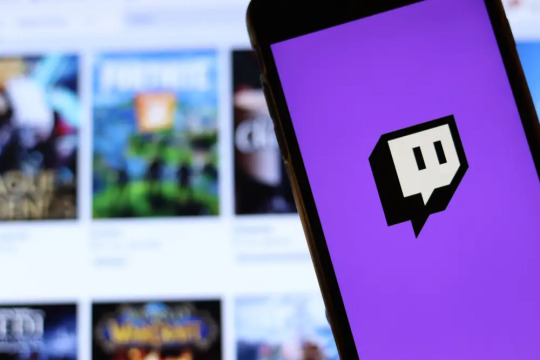
(Image: Business Insider)
The online gaming community has been a constantly evolving community since the inception of the internet. Personally, growing up, I spent a huge amount of time on MMO games such as Club Penguin and Planet Cazmo, and have over time become quite a fan of online gaming content creators such as PewDiePie and others who make similar content. Online gaming provides consumers with a unique sense of community in which online friendships are formed, players are able to participate in large-scale multiplayer titles and endless fun can be had.
Over time the gaming community has grown exponentially; back in the day, "gamers" were seen as specky, nerdy boys who sat at their computers all day, however these days a gamer is anyone and everyone. From mobile games to console titles and PC games, the gaming community has a place for all.
Its humble beginnings through online role play sites and mobile games have quickly grown into expertly designed story games, ESporting events and g=hugely successful franchises.
My personal favourite aspect of the gaming community is the ways in which it can be consumed. One no longer has to buy or build their own gaming PC or console, and can instead opt to watch streams over the likes of Twitch and Discord or YouTube videos to experience the game without playing it themself.

(Image: HubSpot)
Twitch is a perfect example of a streaming site which highlights the development in the online gaming community. With over 2.2 million unique broadcasters and 10 million daily active users by 2017, and 26.5 million by 2020 (Twitch, 2017-2021), Twitch has paved the way for a new-wave content consumption platform in which gameplay is accessible to all and can be monetised for profit. Users create content that combines "gameplay, humor, commentary, and real-time interaction with fans and audiences" to create a truly unique experience (Taylor, 2018, pp.9).
I am personally very excited to see how the gaming community evolves next. What will the next wave be? Will these streaming platforms continue to see success or will a new method of consumption lead us through to the future?
References
Anonymous, 2021, "Twitch Statistics & Charts", TwitchTracker, accessed 20 May 2021,
<https://twitchtracker.com/statistics>
Taylor, TL, 2018, "Broadcasting ourselves", Watch Me Play: Twitch and the Rise of Game Live Streaming, Princeton University Press, pp. 1-23
#mda20009#mda2000921#social media#twitch#online gaming#online streaming#social gaming#gaming#online communities
2 notes
·
View notes
Text
Digital Hate and Trolls: the online playground of bullies

Behind the screen and in the online sphere, bullying and trolling has advanced alongside technology and found its foothold in the services we integrate into our daily lives for ease and enjoyment.
We are constantly plugged in; we walk around with our phones in our pockets, laptops in our bags, and a wifi connection at home ready to sync up with us before we even unlock the front door. At the touch of a screen we can view the latest news, receive directions, order food, and keep in touch with our loved ones. While the digital cyberspace has created many positive opportunities, a portal has opened to make way for a movement of online hate, violence and harm.

For many, the benefits of social media include greater collaboration, communication, accessibility and community, however these online platforms also provide an environment where trolling and bullying present a true danger. The avenues to the negative discourse and malicious relationships on social media are propelled by the option of anonymity; users are given the ability to hide behind a screen or username and hand out a declaration of ill intent and deliver hurtful actions ‘unseen’.
The power behind these actions of trolls and bullies can lead to serious consequences, often impacting demographics summed up by adolescents and minorities who face the brunt of the violence online. Ostini and Hopkins outline that “power and control extend beyond the physical world to the online world and frequently produce real world effects” (2015). Cyberbullying increases the capacity of harassment and additional abuse that vulnerable members of society are continually subject to.

Trolls and bullies exist predominantly in the online sphere, and navigating the world of social media includes the uncomfortable and unwarranted interaction with online users who choose to create their conflict behind the facade and false protection of a screen. Cyberbullies create lasting impacts on the lives of real people, so in the wise words of Harry Styles remember to treat people with kindness, and report any harmful content you may come across in your internet surfing.
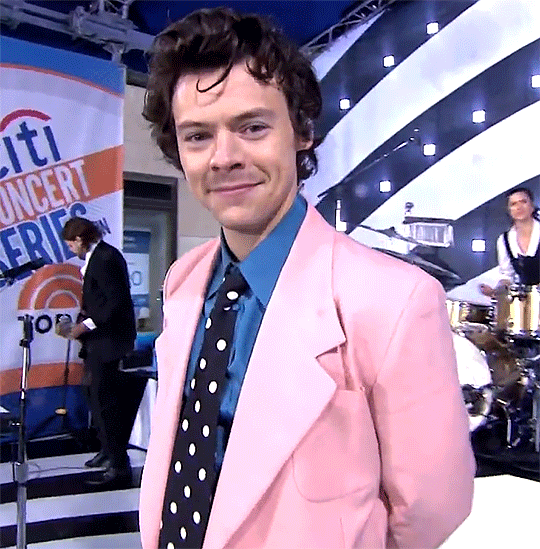
References:
Ostini, J & Hopkins, S 2015, ‘Online harassment is a form of violence’, The Conversation, 8 April, viewed 25 May 2021, <https://theconversation.com/online-harassment-is-a-form-of-violence-38846>.
2 notes
·
View notes
Text
Week 5: What is Digital Citizenship? Hashtag Publics, Political Engagement and Activism
Digital Citizenship can be defined as "an acceptance and upholding of the norms of appropriate, responsible behaviour with regard to the use of digital technologies" (Australian Curriculum, 2010). A good digital citizen is a person who has the skills to effectively used digital technologies and platforms in a way that positively impacts society. Political engagement has changed in the contemporary era and with the recent involvement of social media in political discussions, digital citizenship is very relevant.
In this weeks reading, Vromen states that "the ubiquity of social media in the everyday lives of citizens fosters the development of digital citizenship' (Vromen, 2017). Individuals are adapting to the increased use of social media as a form of broadcasting and communication. New advances of these platforms increase the distribution of individuals ideas and view on certain topics, specifically politics. Hashtag publics allow specific communities about different topics to be bundled together and streamline all ideas and content in one place. Over the past few years, we have seen many publics be created, such as #AusPol, #MeToo, #BlackLivesMatter, #StopAsianHate etc... Most of these hashtags being activism based, they segment people's experiences and opinions in one area and often share contrasting opinions and discussions. Many established political organisations are turning to social media platforms to engage and promote their political processes.

A recent example of this is the 2016 US presidential election campaign. During this campaign social media platforms were increasingly used as direct sources of news, bypassing the editorial media (Enli, 2017). Both Trump and Clinton had millions of followers on Twitter and it became a platform for mass communication and debate. Enli's article explores both Clinton and Trumps tweets and the digital citizenship that they did or did not possess. Donald Trump for example had published many tweets that incorporated name calling, insults and stylistic devices. These platformed discussions during the election created a channel for sharing of political views and voter activation that would not be so widely spread without the use of hashtag publics and political engagement on social media.
References
Australian Curriculum 2010, Glossary, https://www.australiancurriculum.edu.au/f-10-curriculum/english/Glossary/?term=types+of+texts.
Enli, G 2017, "Twitter as arena for the authentic outsider: exploring the social media campaigns of Trump and Clinton in the 2016 US presidential election", European Journal of Communication, vol. 32, no. 1, pp. 50-61.
Vromen, A 2017, Digital Citizenship and Political Engagement, Palgrave Macmillan UK, London, pp. 1-7.
#mda2000921#social media#digital communities#politics#political engagement#public sphere#digital citizenship#hashtag publics
3 notes
·
View notes
Text
Week 6: Body Modification on Visual Social Media
This week’s topic centres around body modification on visual social media and how the need to improve one’s appearance has increased overwhelmingly in popularity. In this post I will be using the social media platform Instagram as an example, as it is a uniquely visual social media channel and is “naturally suited to plastic surgery” (Dorfman et al. 2018, pp. 332). Many celebrities have gotten aesthetic cosmetic surgery before and some even promote it on their social media sites, with the Kardashians and in particular, Kylie Jenner being heavily speculated to have had a Brazilian butt life or implants and her iconic lip fillers. However, due to the explosion of user-generated content online, this has resulted in a plethora of influencers referred to as ‘microcelebrities.’ These microcelebrities use a style of online performance in which individuals attempt to “gain the attention of a ‘following’ on social media through representations of their everyday lives” (Drenten et al. 2020, pp. 42). These ‘representations’ are often unrealistic highlight reels of the user’s life and since “influencer marketing on social media is now a multi-billion-dollar industry, expected to be valued between $5-10 billion by 2020” (MediaKix, 2018) social media influencers now have more power than ever over users and importantly, the younger generation.


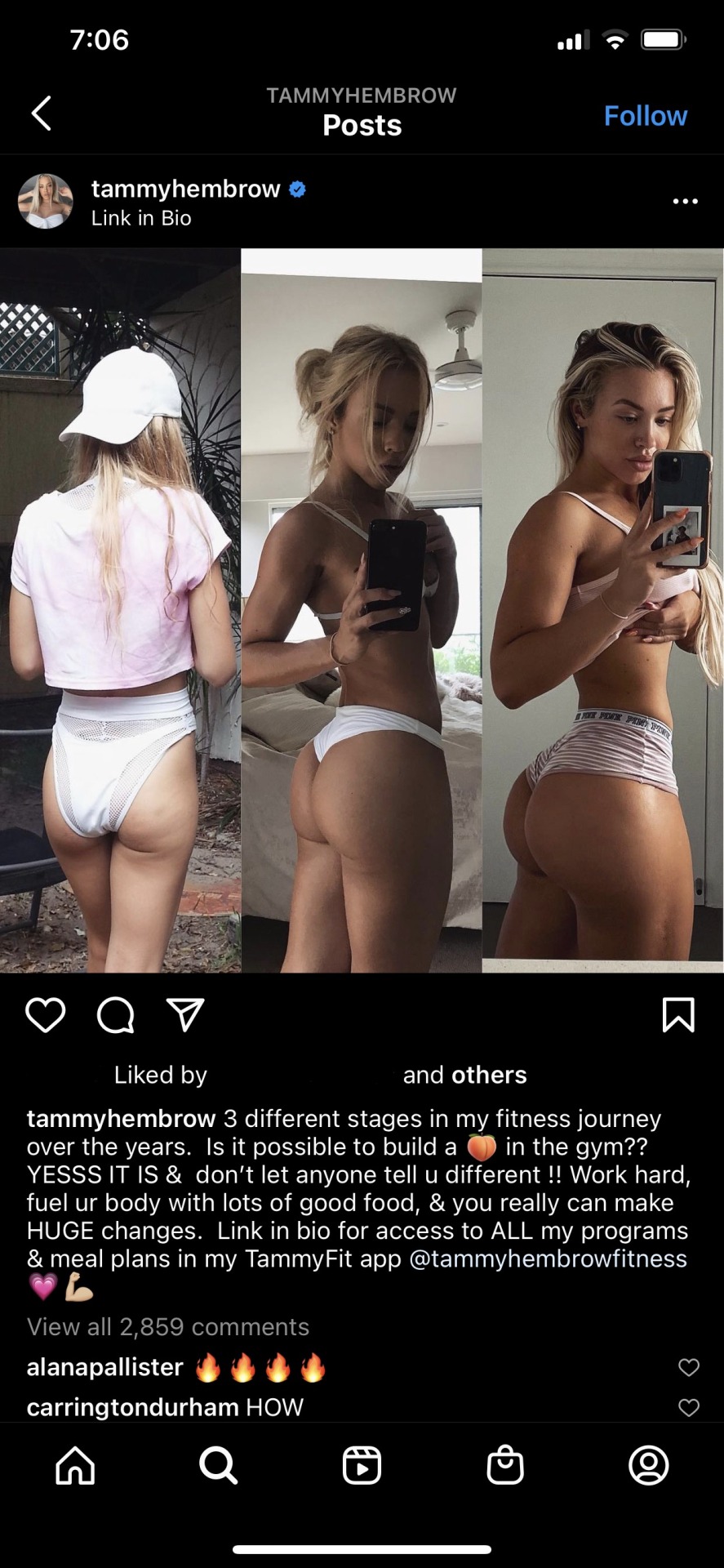
After fending off rumours about aesthetic/cosmetic surgery, 26-year-old Australian influencer, Tammy Hembrow, admitted in her Q&A on her YouTube Channel to getting breast augmentation after giving birth to her daughter. She stated that she had gotten the surgery after she stopped breastfeeding her daughter, Sass, as she said “it sucked the life out of [her] boobs” and that “they were just little saggy pieces of skin after” (Tammy Hembrow, 2020) and wanted to undergo it for herself. Despite Tammy openly posting photos of her new boob job, she also has her own TammyFit workout programs and meal plans to promote growing a natural booty by proving this to her followers with her personal ‘before and after’ photos. Even though the constant exposure and normalisation of plastic surgery on social media can be damaging to youth’s mental health over time, I feel that influencers who are open about their surgery and those who also encourage working towards achieving your body goals naturally can have a positive impact on educating others about the risks and benefits of cosmetic surgery.
Here is a link to Tammy Hembrow’s Q&A YouTube video. Skip to 6:03 to watch her addressing her breast augmentation surgery:
https://www.youtube.com/watch?v=IygC9gzUx3U&t=731s
References:
Dorfman, R, Vaca, E, Mahmood E, Fine, N, Schierle, C 2018, ‘Plastic Surgery-Related Hashtag Utilization on Instagram: Implications for Education and Marketing’, Aesthetic Surgery Journal, vol. 38, no. 3, pp. 332-338
Drenten, J, Gurrieri, L, Tyler, M 2020, ‘Sexualised labour in digital culture: Instagram influencers, porn chic and the monetization of attention’, Gender Work Organ, 2020;27:41-66, <https://doi.org/10.1111/gwao.12354>
Mastroianni, B 2020, “Influencer admits to plastic surgery,” Sunshine Coast Daily, viewed 16 April, 2021, <https://www.sunshinecoastdaily.com.au/news/influencer-admits-to-plastic-surgery/4106344/>.
#mda2000921#bodymodification#breastsurgery#tammyhembrow#cosmeticsurgery#instagram#social media#influencer#microcelebrity#digitalcommunities
4 notes
·
View notes
Text
Social Media: facilitating abuse and hatred? (Week 10)

Within the ‘real world’, people generally understand what bullying is and what it looks like. However, bullying, trolling and other negative-centric behaviours are less easily deciphered from behind a screen. For the many benefits that social media affords its users; collaborativity, communication and collectivity, social media also presents very real and dangerous challenges to those who choose to use it. Now, more than ever, harassment and abuse on social media is at a high. This increased level of harassment means that members of society who are already vulnerable face additional abuse.
Gaslighting is the behaviour of “psychologically manipulating a person in order to erode their sense of self and sanity” (Gleeson 2018). Gaslighting, like many other bullying tactics, originated beyond a screen, however the proliferation of social media and the ability to simulate ‘in person’ interactions has meant the behaviour of gaslighting has become commonplace on social media platforms. Gaslighting is particularly alarming within the online context due to its ability to “unnerve and demoralise” (Gleeson 2018) people.
Social media is often utilised by support groups and social justice movements, using these platforms to inform the masses of issues and invoke change. However, the emergence of gaslighting techniques on social media has aimed to discredit and devalue these groups and movements. For example, the recent #MeToo movement, which encouraged women particularly to publicise situations in which they had been subject to sexual harassment or abuse. However, gaslighting on social media platforms aimed to “dismiss” (Gleeson 2018) these publications, instead stating that these “survivors: had “misread the situation” (Gleeson 2018) or “imagined the abuse” (Gleeson 2018).
However, the increase of harassment and abuse on social media is not limited to specific behaviours such as gaslighting. Harassment and abuse can be harboured on social media merely through groups projecting and posting hateful and ill-informed views and thought on particular subjects.
As identified by Marwick, “harassing behaviours” (Marwick et al, 2018, p. 543) online are becoming more “networked” (Marwick et al, 2018, p. 543), “coordinated and organised” (Marwick et al, 2018, p. 543). That is, users of social media are beginning to organise themselves “loosely” (Marwick et al, 2018, p. 543) into their own social media “networks” (Marwick et al, 2018, p. 543) constituting “blogs, podcasts and forums” (Marwick et al, 2018, p. 543), to engage and spread common thought.
Recently, this has been evidence by the emergence of the “manosphere” (Marwick et al, 2018, p. 543), a social media network which aims to spread messages of “men’s rights” (Marwick et al, 2018, p. 550) and hence dismiss “feminist thought” (Marwick et al, 2018, p. 550) and female equality generally. Like many other collective networks, the “manosphere” (Marwick et al, 2018, p. 543) uses vocabulary and language to connect users to a “common” (Marwick et al, 2018, p. 553) community and hence “identity” (Marwick et al, 2018, p. 553). As the “manosphere” (Marwick et al, 2018, p. 543) is really a collective of many different and “diverse” (Marwick et al, 2018, p. 553) online communities, the use of common language and vocabulary connects these varying communities and therefore evolves the community of hatred and bullying.
Hence, whilst the formation of online networks of similar thought is not inherently subjecting others to harassment and abuse, when these communities main objectives is to spread messages of hatred towards a particular sector in society, these networks further contribute to conflict and bullying on social media. Ultimately, disintegrating the safety and positivity social media aims to employ.
Social media affords many benefits to those who chose to use it. However, these benefits in recent times are potentially being outweighed by the movement of bullying and harassment into online spaces. Whilst this negativity severely disrupts the main objectives of social media in modern society, awareness and reporting of common bullying techniques and networks can assist in alleviating and reducing harassment and abuse online.
References:
Jessamy Gleeson, Research Officer, School of Global, Urban & Social Studies, RMIT University, 'What does Gaslighting Mean?' The Conversation, 2018 , https://theconversation.com/explainer-what-does-gaslighting-mean-107888
Alice E. Marwick & Robyn Caplan, 'Drinking male tears: language, the manosphere, and networked harassment' Feminist Media Studies Volume 18, 2018 - Issue 4: Pages 543-559
#online bullying#social media hate#gaslighting#manosphere#digitaldiscussions#digital communities#social media conflict#mda20009#mda2000921#public sphere
6 notes
·
View notes
Text
Week 9 - Social Media influencers and the slow fashion movement
To be active in online spaces, means that one claims online citizenship. Citizenship can be defined as meaning to carrying out the duties, responsibilities or values of a member of a particular society or group or organisation. (Cambridge) This translates to online spaces as well, especially social media. There are certain obligations and movements which gain traction on social media and thus creates an obligation for users to be aware of the movement, support it or follow it themselves.
A movement like this which is prominent on social media is the slow fashion movement.
The slow fashion is not a new movement, it is linked to the counterculture of the 1960s, the anti-fur campaigns of the 1980s and protests against unethical working conditions that were prominent through the 1990s and early 2000s. (Lai, et al 2017) Slow fashion is also linked to the sustainable consumption movement, a movement which is ‘built on the essential concepts of sustainability values, ethical working conditions and decreasing environmental contaminants’ (Chi, et al 2021).
Sustainable fashion refers to goods that respond to basic needs and bring a better quality of life, while minimising the use of natural resources, toxic materials and emissions of waste and pollutants over the life-cycle. For fashion to be deemed sustainable, the items must be be child labour free across the entire supply chain, materials used in the production process must be as less harmful as possible to the environment, ie recycled or up-cycled. Additionally, the production process must be ethically and socially responsible. This can be done by ensuring paying workers fair wages and suitable working conditions.
In recent years, with the rise of social media, sustainable slow fashion has become more mainstream. Social media platforms have provided the space for more grass roots activists and their work to be shared across larger audiences. There are lots of social media “influencers” who promote sustainable fashion. Some of my favourites (on instagram) are;




(Screenshots are from Instagram.)
References:
‘Citizen’ 2021, in Cambridge Dictionary, viewed 6 May 2021 <
https://dictionary.cambridge.org/dictionary/english/citizen>.
Ting Chi, Jenisha Gerard, Yuhfen Yu & Yuanting Wang 2021 'A study of U.S. consumers’ intention to purchase slow fashion apparel: understanding the key determinants' International Journal of Fashion Design, Technology and Education, 14:1, 101-112, DOI: 10.1080/17543266.2021.1872714
Zhen Lai, Claudia E. Henninger and Panayiota J. Alevizou 2017 ‘An Exploration of Consumers’ Perceptions Towards Sustainable Fashion – A Qualitative Study in the UK’.
3 notes
·
View notes